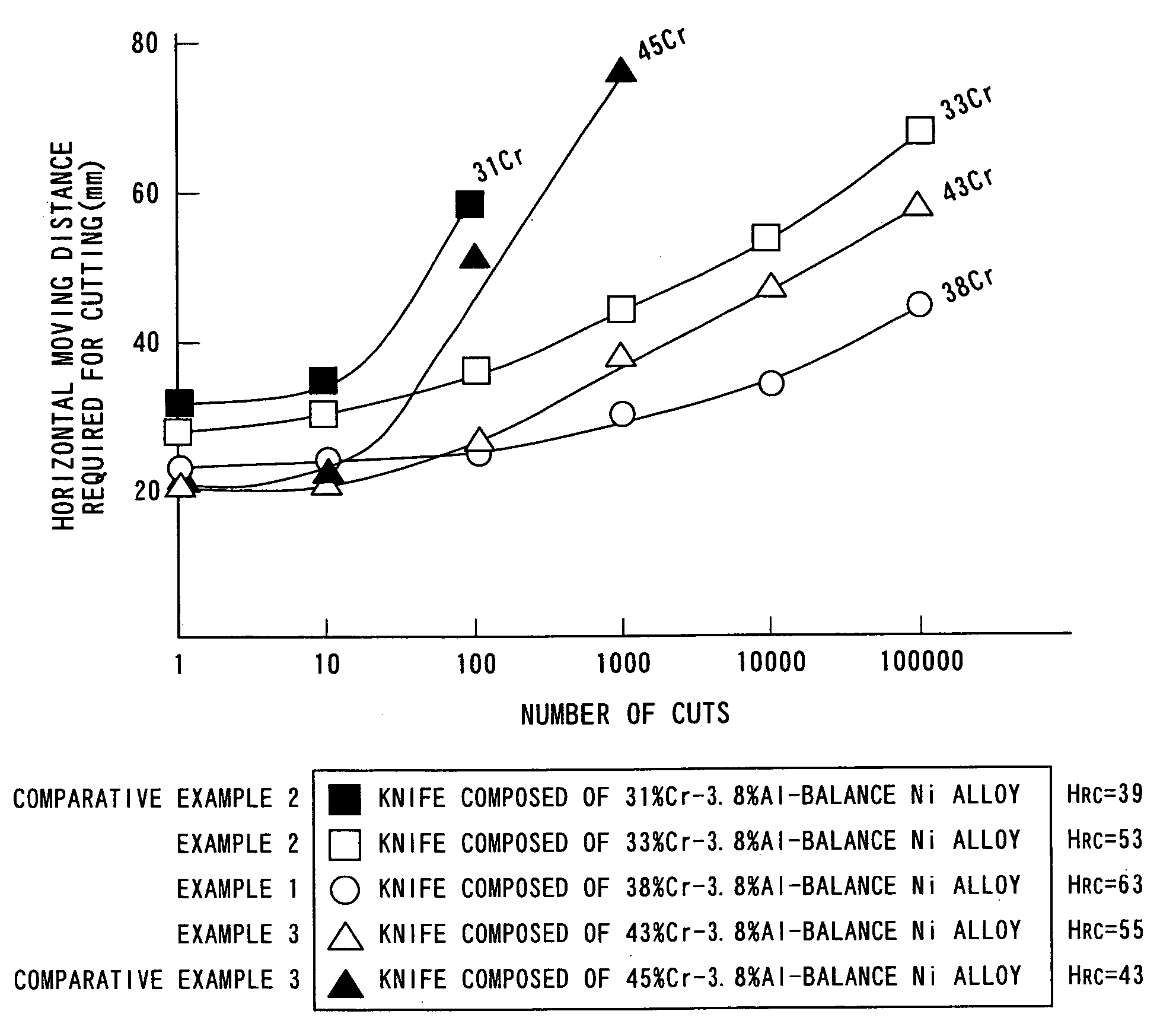Ni-cr alloy cutting tool
a cutting tool and alloy technology, applied in the field of ni-cr alloy cutting tools, can solve the problems of inconvenient use of materials that can satisfy all the above characteristics required for cutters, poor toughness of cutter blanks hardened by quenching, and brittleness without further treatment, so as to achieve superior workability, reduce production costs of cutters, and simplify the production process
- Summary
- Abstract
- Description
- Claims
- Application Information
AI Technical Summary
Benefits of technology
Problems solved by technology
Method used
Image
Examples
example 1
[0069] A Ni—Cr alloy having a composition of 38% Cr-3.8% Al-balance Ni was melted and cast by a vacuum melting process. Subsequently, the resultant alloy was forged and rolled to prepare a blank plate 1 shown in FIG. 1 having a dimension of 300 mm in width×2,000 mm in length×4.4 mm in thickness. This blank plate 1 was subjected to solution heat treatment at 1,200° C. in a vacuum heat treatment furnace adjusted in argon atmosphere and was then submerged into oil to quench. Subsequently, the surface of the blank plate 1 was ground by 0.2 mm to remove an alteration layer generated by quenching.
[0070] The resultant blank plate 1 (300 mm in width×2,000 mm in length×4 mm in thickness) was cut with a laser cutter to prepare a formed body 3 having a knife shape. In the formed body 3, the dimension of the blade part was 160 mm×40 mm, and the dimension of the grip part was 80 mm×20 mm. Grip-fixing holes 2 were formed with a drilling machine at the grip part of the formed body 3. Furthermore,...
example 7
[0091] As shown in Tables 1 and 2, the following various alloys were produced using a base alloy composition of 38 mass percent Cr-3.8% Al-balance Ni. Chromium in the alloy was partly replaced with at least one element selected from Zr, Hf, V, Nb, Ta, Mo, and W. Aluminum in the alloy was partly replaced with Ti. The contents of impurities and additional trace elements were varied. For example, each content of C, Mn, P, O, S, Cu, and Si, the total content of P, O, and S, the total content of Mn, Cu, and Si, each content of Mg, Ca, B, and rare earth elements (RE), and the total content of Mg, Ca, B, and rare earth elements (RE) were varied to prepare the various alloys.
[0092] Subsequently, forging, rolling, solution heat treatment, quenching, grinding, and aging heat treatment were performed as in Example 1 using the above alloys to prepare blanks for the cutters. Furthermore, the grip was combined as in Example 1 to produce knives according to Example 7.
[0093] In the knives accordi...
example 8
[0099] Alloys were produced by partly replacing Ni in an alloy composed of 38 mass percent Cr-3.8% Al-balance Ni with Fe. The replacement ratio of Fe was varied. The alloys were subjected to machining and heat treatment as in Example 1 to prepare knives having the same dimensions as that in Example 1. The surface hardness of the knives was measured with a Rockwell hardness tester to investigate the effect of the replacement ratio of Fe on the hardness of the knives. FIG. 7 shows the result.
[0100] As clearly shown in FIG. 7, when the replacement ratio of Fe was 5 mass percent or less, the hardness specified in the present invention (i.e., HRC52 or more) was maintained. On the other hand, when the replacement ratio of Fe exceeded 5 mass percent, the hardness of the knife was drastically decreased. Such an excessive replacement is not preferable because basic characteristics such as the blade durability are deteriorated. Accordingly, when the replacement ratio of Fe is 5 mass percent ...
PUM
| Property | Measurement | Unit |
|---|---|---|
| grain size | aaaaa | aaaaa |
| temperature | aaaaa | aaaaa |
| temperature | aaaaa | aaaaa |
Abstract
Description
Claims
Application Information
 Login to View More
Login to View More - R&D
- Intellectual Property
- Life Sciences
- Materials
- Tech Scout
- Unparalleled Data Quality
- Higher Quality Content
- 60% Fewer Hallucinations
Browse by: Latest US Patents, China's latest patents, Technical Efficacy Thesaurus, Application Domain, Technology Topic, Popular Technical Reports.
© 2025 PatSnap. All rights reserved.Legal|Privacy policy|Modern Slavery Act Transparency Statement|Sitemap|About US| Contact US: help@patsnap.com



